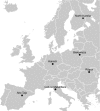Fungal disease incidence along tree diversity gradients depends on latitude in European forests
- PMID: 27066232
- PMCID: PMC4788975
- DOI: 10.1002/ece3.2056
Fungal disease incidence along tree diversity gradients depends on latitude in European forests
Abstract
European forests host a diversity of tree species that are increasingly threatened by fungal pathogens, which may have cascading consequences for forest ecosystems and their functioning. Previous experimental studies suggest that foliar and root pathogen abundance and disease severity decrease with increasing tree species diversity, but evidences from natural forests are rare. Here, we tested whether foliar fungal disease incidence was negatively affected by tree species diversity in different forest types across Europe. We measured the foliar fungal disease incidence on 16 different tree species in 209 plots in six European countries, representing a forest-type gradient from the Mediterranean to boreal forests. Forest plots of single species (monoculture plots) and those with different combinations of two to five tree species (mixed species plots) were compared. Specifically, we analyzed the influence of tree species richness, functional type (conifer vs. broadleaved) and phylogenetic diversity on overall fungal disease incidence. The effect of tree species richness on disease incidence varied with latitude and functional type. Disease incidence tended to increase with tree diversity, in particular in northern latitudes. Disease incidence decreased with tree species richness in conifers, but not in broadleaved trees. However, for specific damage symptoms, no tree species richness effects were observed. Although the patterns were weak, susceptibility of forests to disease appears to depend on the forest site and tree type.
Keywords: Diversity gradient; Europe; FunDivEUROPE; foliar fungal pathogen; forests; latitudinal gradient; tree species richness.
Figures



Similar articles
-
Bat and bird diversity along independent gradients of latitude and tree composition in European forests.Oecologia. 2016 Oct;182(2):529-37. doi: 10.1007/s00442-016-3671-9. Epub 2016 Jun 16. Oecologia. 2016. PMID: 27312262
-
Tree diversity reduces pest damage in mature forests across Europe.Biol Lett. 2016 Apr;12(4):20151037. doi: 10.1098/rsbl.2015.1037. Biol Lett. 2016. PMID: 27122011 Free PMC article.
-
Tree diversity and the role of non-host neighbour tree species in reducing fungal pathogen infestation.J Ecol. 2014 Nov;102(6):1673-1687. doi: 10.1111/1365-2745.12317. Epub 2014 Oct 24. J Ecol. 2014. PMID: 25558092 Free PMC article.
-
Biodiversity differences between managed and unmanaged forests: meta-analysis of species richness in Europe.Conserv Biol. 2010 Feb;24(1):101-12. doi: 10.1111/j.1523-1739.2009.01399.x. Conserv Biol. 2010. PMID: 20121845 Review.
-
Adaptive Relationships in Hemi-Boreal Forests: Tree Species Responses to Competition, Stress, and Disturbance.Plants (Basel). 2023 Sep 13;12(18):3256. doi: 10.3390/plants12183256. Plants (Basel). 2023. PMID: 37765418 Free PMC article. Review.
Cited by
-
Spatial Pattern of Host Tree Size, Rather than of Host Tree Itself, Affects the Infection Likelihood of a Fungal Stem Disease.Biology (Basel). 2024 Aug 14;13(8):616. doi: 10.3390/biology13080616. Biology (Basel). 2024. PMID: 39194554 Free PMC article.
-
Nutrient status not secondary metabolites drives herbivory and pathogen infestation across differently mycorrhized tree monocultures and mixtures.Basic Appl Ecol. 2021 Sep;55:110-123. doi: 10.1016/j.baae.2020.09.009. Epub 2020 Sep 28. Basic Appl Ecol. 2021. PMID: 34493930 Free PMC article.
-
Worldwide diversity of endophytic fungi and insects associated with dormant tree twigs.Sci Data. 2022 Mar 1;9(1):62. doi: 10.1038/s41597-022-01162-3. Sci Data. 2022. PMID: 35232978 Free PMC article.
-
Comparison of Microbial Diversity of Two Typical Volcanic Soils in Wudalianchi, China.Microorganisms. 2024 Mar 26;12(4):656. doi: 10.3390/microorganisms12040656. Microorganisms. 2024. PMID: 38674601 Free PMC article.
-
Foliar fungi of Betula pendula: impact of tree species mixtures and assessment methods.Sci Rep. 2017 Feb 2;7:41801. doi: 10.1038/srep41801. Sci Rep. 2017. PMID: 28150710 Free PMC article.
References
-
- Baeten, L. , Verheyen K., Wirth C., Bruelheide H., Bussotti F., Finér L., et al. 2013. A novel comparative research platform designed to determine the functional significance of tree species diversity in European forests. Perspect. Plant Ecol. Evol. Syst. 15:281–291.
-
- Barbosa, P. , Hines J., Kaplan I., Martinson H., Szczepaniec A., and Szendrei Z.. 2009. Associational resistance and associational susceptibility: having right or wrong neighbors. Annu. Rev. Ecol. Evol. Syst. 40:1–20.
-
- Bartoń, K. 2015. MuMIn: Multi‐Model Inference. R package version 1.13.4.
-
- Bates, D. , Maechler M., Bolker B., and Walker S.. 2014. Fitting Linear Mixed‐Effects Models Using lme4. J. Stat. Software 67:1–48.
-
- Boyd, I. L. , Freer‐Smith P. H., Gilligan C. A., and Godfray H. C. J.. 2013. The consequence of tree pests and diseases for ecosystem services. Science 342:823–830. - PubMed
LinkOut - more resources
Full Text Sources
Other Literature Sources

